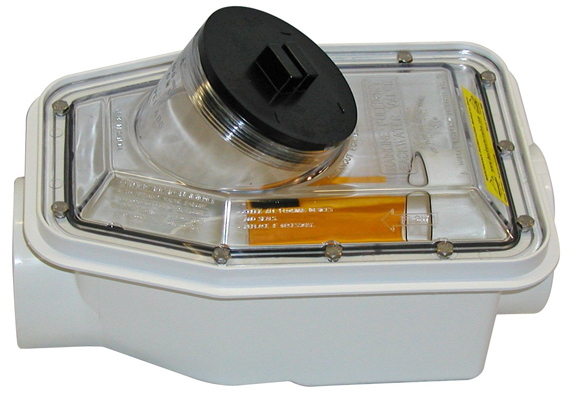Mainline Fullport Backwater Valve
The Mainline #4963 Full-Port Backwater Valve is the ‘flagship’ of the company. Established in 1997, this valve has revolutionized sewer protection across North America with its patented ‘normally open’ gate design. This valve is typically installed in homes or buildings that have basements, cellars, crawl spaces or area that are accessible for servicing. The normally open gate allows the sewer system to ‘vent’ any gases that may be causes by positive or negative pressures in the sewer line. The 4963 has a ‘Clear View’ top that makes inspection of the valve quick and simple for the building owner or plumber! As well, the 4963 comes with an integral clean-out for rodding the sewer lateral. Should rodding from the stack be necessary, the snake can easily pass over the open gate and be retracted with out doing any harm to the components.

The #2013 Access Box is a very useful accessory to the 4963 valve. Its dimensions of: length 20 in; width of 12.5 in; and height of 16 in make accessing the 4963 for servicing a very easy task!
Features and benefits:
“Normally-open design” offers zero flow restriction
“Normally-open design” allows free circulation of air through the Plumbing System
“Clear Lid” easy visual inspection of unit
“Built-in main-sewer cleanout” allows auguring of sewer

What keeps the valve Clean?
Gate has 2% built in grade in the design
Bottom of gate on body has 4% built in grade in the design
Side Channels have 8.25% built in grade in the design
With the valve installed at 2% minimum grade as per installation instructions!
Results: Gate 4% grade
Body 6% grade
Channels 10.25%
Flow Channels:
Flow channels prevent sewage from penetrating gate and valve bottom and float area upon normal flow conditions
Built in flow channels on gate direct sewage out onto body
Built in flow channels on body direct sewage out of body
How Hinge area is protected from contamination
At the bottom of the valve you will notice dams, the gate in the open position rests on these dams preventing any flow from circling back from the outlet side of the gate and penetrating back into the hinge area,
At the front of the dams is drain port, this port drains away any water which may seep under the gate through the inlet side of the valve
Gate Function
Gate is fitted with closed cell polyethylene floats, this flotation material is impervious to sewage and will not become water logged (gate design locks floats in place)
Upon a slow reversal flow, water rises in the body and the gate starts to float (lift). Once the gate starts to lift the water flow in turn pushes the gate into the gate position.
Upon a quick reversal: The gate is fitted with 45 degree angles on the front which act as wings, upon quick reversal action water is diverted into the wing area through the flow channels. Water then pushes up on the 45 degree angles causing the gate to quickly close.
O-ring is used on the body for positive seal.
Built-in Sewer Cleanout
The built-in sewer clean out is downstream of the gate, a sewer tape will not catch on the gate when feeding or retrieving the cable
Bolted Gasketed Cover
Nuts and Bolts are Stainless Steel
Polycarbonate transparent lid provides a visual inspection of the unit at all times
Certification
CSA B181 (ABS) B182 (PVC)
UPC IAPMO PS-38 Standard
History
Developed in 1997
Over 400,000 in the ground
Used throughout Canada, and certain parts of the US
Maintenance
Backwater valves are mechanical devices sitting in a sewage environment, and regular inspections are required. To ensure the satisfactory performance of the backwater valve follow the procedures listed below.
1. Remove the cleanout plug on the top of the valve and do a visual inspection.
2. Take a flashlight or trouble light to properly see inside the valve body.
3. Inspect for debris build-up on the body, gate and beneath the gate.
4. If debris build-up is found flush clean.
5. Inspect o-ring and replace if necessary. The valve's gate seals against
an o-ring on the body ( in the closed position).
6. Ensure gate freely moves up and down.
7. Reinstall cleanout plug.
On models fitted with closed cell polyethylene floats, check the condition of floats and replace as necessary. * Note: these floats are located on both sides of the gate and are protected from sewage contamination by the sidewalls of the gate and body (long-life cycle, impervious to sewage). CSA certified floats.
Bolted Cover
Dimensions



